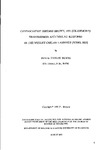CRYPTOCARYON IRRITANS BROWN, 1951 (CILIOPHORA): TRANSMISSION AND IMMUNE RESPONSE IN THE MULLET CHELON LABROSUS (RISSO, 1826)
| dc.contributor.author | BURGESS, PETER JOHN | |
| dc.contributor.other | School of Biological and Marine Sciences | en_US |
| dc.date.accessioned | 2013-11-06T13:08:27Z | |
| dc.date.available | 2013-11-06T13:08:27Z | |
| dc.date.issued | 1992 | |
| dc.identifier | NOT AVAILABLE | en_US |
| dc.identifier.uri | http://hdl.handle.net/10026.1/2632 | |
| dc.description.abstract |
A standardised procedure was established for the laboratory maintenance of C.irritans in thick-lipped mullet. Nine isolates of C.irritans were obtained of which eight were successfully established for up to 48 weeks. Studies on individual life cycle stages with regards to longevity, viability, and susceptibility to a chemotherapeutic agent, revealed the difficulties in eradicating the cysts. Transmission of the parasite both to and from the host correlated with darkness. High infection levels resulted in the death of host fish within five days following exposure to theronts. An acquired protective immune response developed in host mullet within 14 days after exposure to sub-lethal infection. The degree of immunity appeared to relate to infection dose, and was not fully protective in all fish. Protection persisted for six months after infection and appeared specific to C.irritans. Specific antibodies to trophont antigen were identified in mullet serum but not epithelial mucus following either natural exposure to theronts or intraperitoneal immunisation with trophont antigens. Serum from intraperitoneally immunised fish caused theront immobilisation and agglutination in vitro; however no evidence was found for a protective role for specific antibody. Major polypeptides were identified and characterised by molecular weight for both trophont and theront stages using SDS-PAGE. Significant homology in major polypeptide profiles was found between C.irritans and I.multifiliis, in respect to trophonts and particularly theronts. Murine monoclonal antibodies raised to trophonts identified two polypeptide components of molecular weights 20-21kDa and 68-69kDa, the latter being homologous with host immunoglobulin heavy chain. These results are discussed in relation to future management and control strategies for cryptocaryosis in warmwater mariculture systems and aquaria. | en_US |
| dc.language.iso | en | en_US |
| dc.publisher | University of Plymouth | en_US |
| dc.title | CRYPTOCARYON IRRITANS BROWN, 1951 (CILIOPHORA): TRANSMISSION AND IMMUNE RESPONSE IN THE MULLET CHELON LABROSUS (RISSO, 1826) | en_US |
| dc.type | Thesis | |
| plymouth.version | Full version: final and full version as approved by the examiners at the time of the award of your degree | en_US |
| dc.identifier.doi | http://dx.doi.org/10.24382/4867 | |
| dc.identifier.doi | http://dx.doi.org/10.24382/4867 |
Files in this item
This item appears in the following Collection(s)
-
01 Research Theses Main Collection
Research Theses Main


